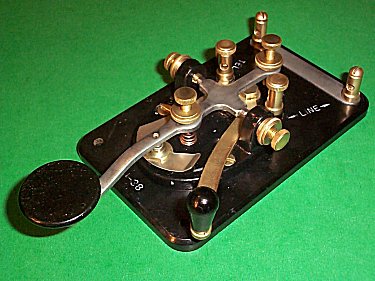
*Keys, Bugs and Paddles*
This article started out as a post on the Rubicon inquiring into the difference between various types of equipment for sending Morse Code over the radio. Ham radio slang is almost indecipherable, and there’s nothing about the word “bug” that would lead you to understand what it is. I know I did more than just a bit of haphazard searching, when I first became interested in amateur radio, trying to collect the information I’ve condensed into the response to the Rubie and into this short article.
The first thing you need to know is that keys, paddles, bugs, whatever, are nothing more than switches. They close and open a circuit in your radio and nothing more. The other stuff going on inside your radio is quite wonderful and mysterious—there’s something almost approaching alchemy about communicating via radio. But I digress.
Keys are switches. That’s all.
Here's a straight key, a J-38 military model:

(American keys have always been more slender and delicate looking than the massive European ones):
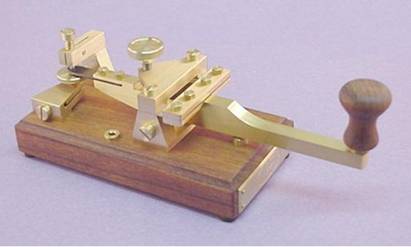
Swedish straight key
It's a simple "button" switch, only adjustable for the amount of travel up/down and the spring tension.
New ones can cost as little as $10-$20 for a simple American straight key, up to several hundred dollars. Stick with the inexpensive ones; a very good key can be had for no more than $50.00, and the ones in the nosebleed section aren’t that many times better.
Here's a "bug," also called a "semi-automatic key." It is the Vibroplex "Lightning Bug," designed in 1906 or thereabouts and adopted also by the military as the J-39 (this one was made under license by the Lionel Electric Train Company - yes, that Lionel):
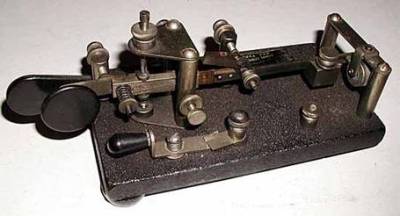
The Vibroplex Company still makes these instruments, as do others:
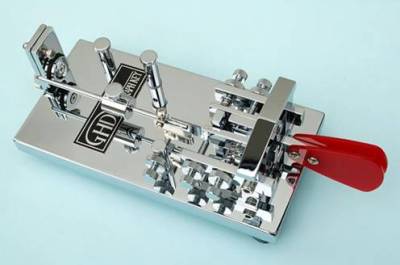
A very elegant Japanese bug
They work like this. Rather than push a button, you work that paddle thingamajig side-to-side. When you push it to the left, it closes with the circuit in the exact same way a straight key does, and bounces right back like a straight key. This is to form your "dahs." When you push it to the right, all that ironmongery in back kicks in. The weight, the little spring doohickey and a tiny spring you can't see, all make it bounce back and forth against a second contact, making the "dits." It will keep bouncing back and forth, "dididididididit" until you let go. It's called "semi-automatic" because it makes the dits for you, but you have to make the dahs the right length on your own.
Used ones on Ebay can go for as little as $70 or so (caveat emptor). New ones run about $170 up to a few hundred.
This is a "paddle"
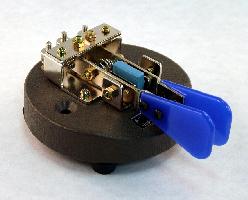
As you can see, there are two little paddles. They work much the same as the "bug" above, except they are fully automatic, working with special circuitry in your radio. When you push the paddle on the right, it makes a series of perfectly spaced dahs; when you push the paddle on the left, it makes a series of perfectly spaced dits.
Paddles are priced similarly to bugs.
They're all switches, but they do their work differently.
Of the examples shown, I own a straight key similar to but simpler than the J-38 (its nomenclature is J-44 but it’s functionally identical), as well as a Vibroplex version of the Lightning Bug above. Of the two, the former is more portable, but the bug is more fun to operate once adjusted properly. I also own a dinky little key made by Whiterook that isn’t very comfortable to use for a long time, but it’s incredibly small and just the thing for taking a small radio backpacking.
One more thing…
That little lever on the side of the American straight key and the bug is a knife switch called a "shorting bar." It's an "all-the-time-on" switch, a throwback to older CW rigs that had to be tuned up to match a frequency. It's basically a "helping hand," making a continuous tone while you tune up, so you don't have to have one hand holding down the key while the other one does all the work. Once the radio was tuned, the shorting bar was moved to the "off" position. Modern solid-state radios don’t need this feature as a rule.
And yet one more thing…
Remember how I said that a straight key costing more than $50.00 was a waste of money? You might well wonder then, why I even bothered mentioning bugs and paddles that start out costing three times my ceiling for straight keys.
It has to do with a visit I paid my doctor about 9 years ago. I called upon Dr. Gasceau to ask why my right wrist hurt so badly. He asked me what I did for a living, chatted with me for a while (he was that obsolete kind of doctor that actually talked with his patients—I miss him dearly), and found out that I had an interest in radio. He asked me if I did Morse Code, to which I answered yes. He then related the following story:
“I once had a patient, a carpenter by trade, who came in with a very swollen, very painful left thumb. I asked him about the mechanism of injury, and he said that this happened every time he hit himself with a hammer, and he asked me what he should do about it. I wrote him the following prescripton…” Whereupon he handed me a prescription slip on which he’d written the following Rx: ‘Stop hitting yourself with the damn hammer you idiot!’”
He told me my injury resulted as much from my use of a straight key as it did from my spending all day at a computer. He sent me on my way with a brace for my wrist and told me to look into different kinds of keys (he remembered them from railroad depots—like I said, he’s a doctor you won’t find anymore), and also get off my butt, out of the office and into the field where the fresh air and exercise would do me good as well.
The added expense of a high-end straight key is wasted, but the added expense of a bug or paddle is money saved at the doctor’s office, because they don’t make them like Dr. Gasceau anymore.
gvi
www.alpharubicon.com
All materials at this site not otherwise credited are Copyright © 1996 - 2009 Trip Williams. All rights reserved. May be reproduced for personal use only. Use of any material contained herein is subject to stated terms or written permission.